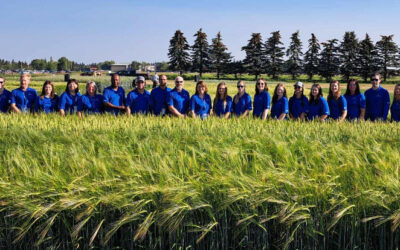The following piece is from our sister publication, Seed World.
At the American Seed Trade Association’s Vegetable and Flower Conference, businesses talk about consumer preferences towards gene edited foods.
When it comes to gene edited foods, the world’s your oyster. Though the agriculture community was worried about the reception of vegetables created using gene editing — particularly due to the public’s reactions to GMOs — consumers are more open to the idea of products created by gene editing, according to panelists at the American Seed Trade Association’s (ASTA) Vegetable and Flower Conference.
Over the past 10 years, companies like North Hill Group — a business that helps seed businesses and plant breeding businesses file their gene edited products for regulatory approval — have seen an uptick in product submissions.
“Ten years ago, you had a very narrow set of companies making 90 per cent of regulatory filings for a narrow set of products,” says Jeff Nawn, CEO of North Hill Group. “Today, it’s something like literally dozens of companies around the world developing products such as coffee, blackberries, cabbage, mustard greens, potatoes, chili peppers, apples… Just about everything you can imagine looking at disease resistance, productivity and consumer traits.”
Nawn says if your company is working towards gene edited products or you work in the seed sector, it’s exciting news, especially as gene editing seems to be accepted by more countries than GMOs were at one point in time.
In fact, most of the gene editing pioneers wouldn’t be companies you’d think of immediately in terms of agriculture innovations. Countries like Guatemala and Honduras are leading the way to adopting more positive regulations towards gene editing.
“We’re finding well educated, highly curious people that want to understand the products that are being developed,” Nawn says, adding that Guatemala holds the fastest record for approving gene edited products, where they reviewed and issued the determination of a nonregulated status within 36 hours.
“While there are a number of countries embracing the technology, there’s another set of countries where we’d say there are opportunities for improvement — that’s the best way to put it,” Nawn says.
Mexico, the United State’s second-largest agricultural export market, hasn’t started contemplating or drafting gene editing regulations. South Korea, the fifth largest agricultural export market, has drafted revisions which are currently pending, but as they stand now, they call for a complicated system and review process. Nawn also sees it nearly impossible to imagine a future where gene edited products are regulated more efficiently than GMOs in the European Union as well as China.
Though the conversation might be difficult to broach with consumers, Bayer’s Lee Quarles sees a path forward to take control of the conversation. Unlike the early days of GMOs, where the industry thought the science could speak for itself, with the onset of online presence and messaging, joining the conversation is important.
“With the advent of social and online spaces, we’ve really leaned back into the conversation to work to take it back,” Quarles, global insights and research lead for Bayer, says. “It’s a great opportunity for all of us in this space to continue to identify ways to communicate.”
Quarles notes that in the discussion of new agricultural innovations, there are three voices that really move the needle: regulatory authorities, science leaders and the rise of a new segment — nutritionists and dietitians.
When it comes down to it, Quarles saw one important thing in terms of gene edited products: consumers want transparency, especially in areas such as food labels and information about the food they’re consuming.
“Communication about the science is just as important as the science itself,” he says.
Gene Edited Successes
While some governments still aren’t open to the idea of gene edited products, in countries where gene edited products are allowed, there have been successes in the food realm. The key? According to Nawn, you need to have a local presence ready to back the product.
“For the most part, consumers told us that they trust their local food co-op,” Nawn says. “There was a level of distrust amongst all age cohorts for government spokesmen about the safety of their food. I guess if I were designing a messaging campaign, I would start there— not with traditional academics.”
One product was launched in Japan — the Sicilian Rouge High GABA tomato. This tomato from Sanatech Seed Co. was the first food to be considered as a CRISPR commercialized variety.
The big thing about the tomato variety? According to Shimpei Takeshita, chief innovation officer of Sanatech Seed Co., the breeders were striving for a tastier tomato with increased health benefits. With the introduction of a high GABA tomato, they were able to achieve just that.
GABA, for those unfamiliar with it, is a health-promoting functional substance— it’s a gamma-aminonbutyric acid that is sold as a dietary supplement in many countries, including Japan.
Takeshita says that the company looked at GABA specifically because it’s proven to suppress high blood pressure, which can help prevent hypertension, stroke and heart attacks.
As for their marketing approach, Takeshita says the company focuses on messages that provide scientific evidence.
“Our marketing system is intended to help consumers make informed choices about the food they eat,” he adds.
Takeshita wasn’t the only one who found success in terms of gene edited food products. Other companies, like Pairwise, have also seen success by being transparent about their products.
In a campaign called Conscious Greens — to learn more about how consumers feel about gene edited products and to showcase products they developed using gene editing — Pairwise employees traveled to three locations in the U.S. And, from that campaign, Megan Thomas, vice president of marketing and communications of Pairwise, says there’s plenty of opportunities to educate.
“Only about nine per cent [surveyed] felt that they knew much about gene editing,” she says. “As we look at younger adults and the Gen Z who are just coming into adulthood, there’s very different attitudes and behaviors. It’s exciting to them.”
Within those education opportunities, Thomas says the consumer needs to understand how gene editing technology is delivering on something important to them. How can you make that message more personal?
Instead of focusing on the science, focus on ideas about nutrition or flavor, or even bigger, more societal ideas — how gene editing can help climate change and sustainability as well as food access.
“Balancing that individual need in that larger community is important,” she says.
While on this campaign and asking consumers about their thoughts of gene editing, Pairwise took it one step further: they served free dishes of a gene edited leafy greens salad — one specifically aimed at increasing the taste and nutrition of prepackaged salad mixes.
“Consumers are smart,” Thomas says, adding that consumers want to understand the differences in their options in the grocery stores between one prepackaged spinach and another. “People are hungry for innovation, and there’s tremendous innovation that’s coming in and consumers love it. How do we bring that spirit of innovation into prepackaged salads? Differentiation is hard to produce. Gene editing unlocks all these opportunities for us to actually create that innovation from a technical standpoint and deliver it for consumers.”
Particularly, Pairwise focused on increasing the flavor of more nutrient dense leafy greens, like spinach and kale, using mustard greens as a flavor base. While in the field in Seattle, the Bay Area and Austin, 3,000 people took a survey about the gene edited product — only one per cent of people had concerns about the products being made with gene editing.
While gene editing might be a new technology to consumers, overwhelmingly, it seems as if consumers are eager to try new innovations once they come to market.
Related Articles
Gene Editing Excites the Minds, and Taste Buds, of Consumers





